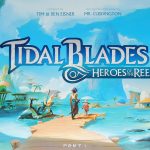
Monsters are encroaching on the islands of the reef once again, so it is time for a tournament to select the new Tidal Blades. Will you prevail in the arenas?
In Reaping the Rewards, I take a look at the finished product from a crowdfunding campaign. Tidal Blades: Heroes of the Reef was originally funded on Kickstarter in the fall of 2018, and was delivered to backers in late 2020. The stand-alone sequel, Tidal Blades 2: Rise of the Unfolders, is on Kickstarter now, along with an RPG set in this world. This review is modified from my original Kickstarter Tabletop Alert to show the finished components.
What Is Tidal Blades: Heroes of the Reef?
Tidal Blades: Heroes of the Reef is a worker-placement game for 2 to 4 players, ages 14 and up, and takes about 60–90 minutes to play. The base game retails for $60 and the deluxe edition retails for $119; both can be ordered directly from the publisher, though the deluxe edition is currently on backorder. The game has a lot of moving parts, but I think kids 10–12 years old who have some gaming experience (and the patience) would be able to handle it; there’s nothing inappropriate for kids in the theme. (I’ve played it with my 8-year-old.)
Tidal Blades was designed by Tim and Ben Eisner, based on a concept and illustrations by Mr. Cuddington. It’s published by Skybound Tabletop and Druid City Games.
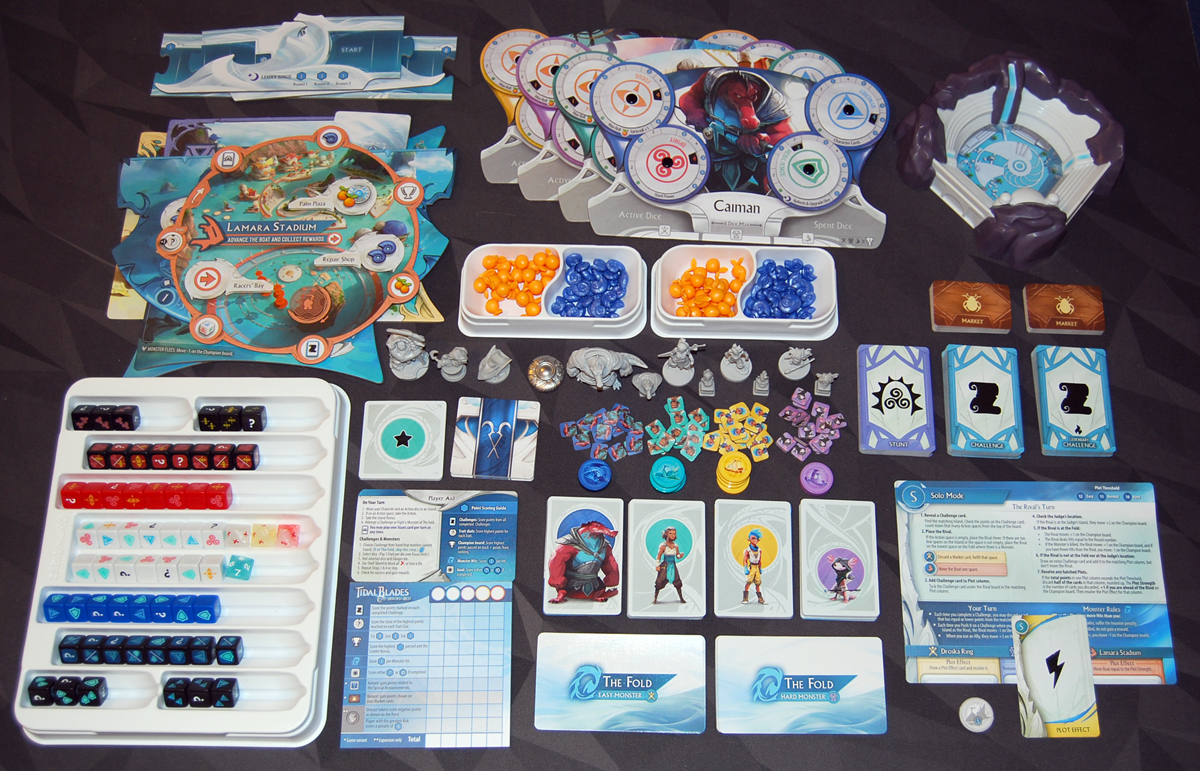
Tidal Blades: Heroes of the Reef Components
I received a deluxe edition, pictured above. I’ll note the differences between the base and deluxe edition in the components list, with more details to follow. (Some of the components have different names than what was used for the prototype.)
- Champion board
- 5 Islands boards
- 4 Sets of player components, each containing:
- Player board
- Character miniature (deluxe only; basic includes standees)
- Champion Board tracker (deluxe only)
- Story card
- 18 Hit tokens
- 4 Action discs
- 13 Character cards
- 3 Secret Goal cards
- 3 Starting Challenge cards
- Player Reference card
- Chronosseum dice tray (deluxe only)
- 35 Fruit tokens
- 45 Shell tokens
- 62 dice
- 14 Novice dice (white)
- 16 Initiate dice (8 blue, 8 red)
- 16 Elite dice (8 black with blue background, 8 black with red background)
- 12 Guild dice (black)
- 3 Danger dice
- Monster Invasion die
- 16 Monster cards (6 regular, 10 advanced)
- 44 Market cards (25 regular, 19 advanced)
- 30 Stunt cards
- 71 Challenge cards (42 regular, 29 advanced)
- 7 Special Announcement cards (for advanced rules)
- Judge Miniature (deluxe only; basic includes standee)
- Current Round marker
- Boat miniature (deluxe only; basic includes standee)
- First Player marker
- Scorepad
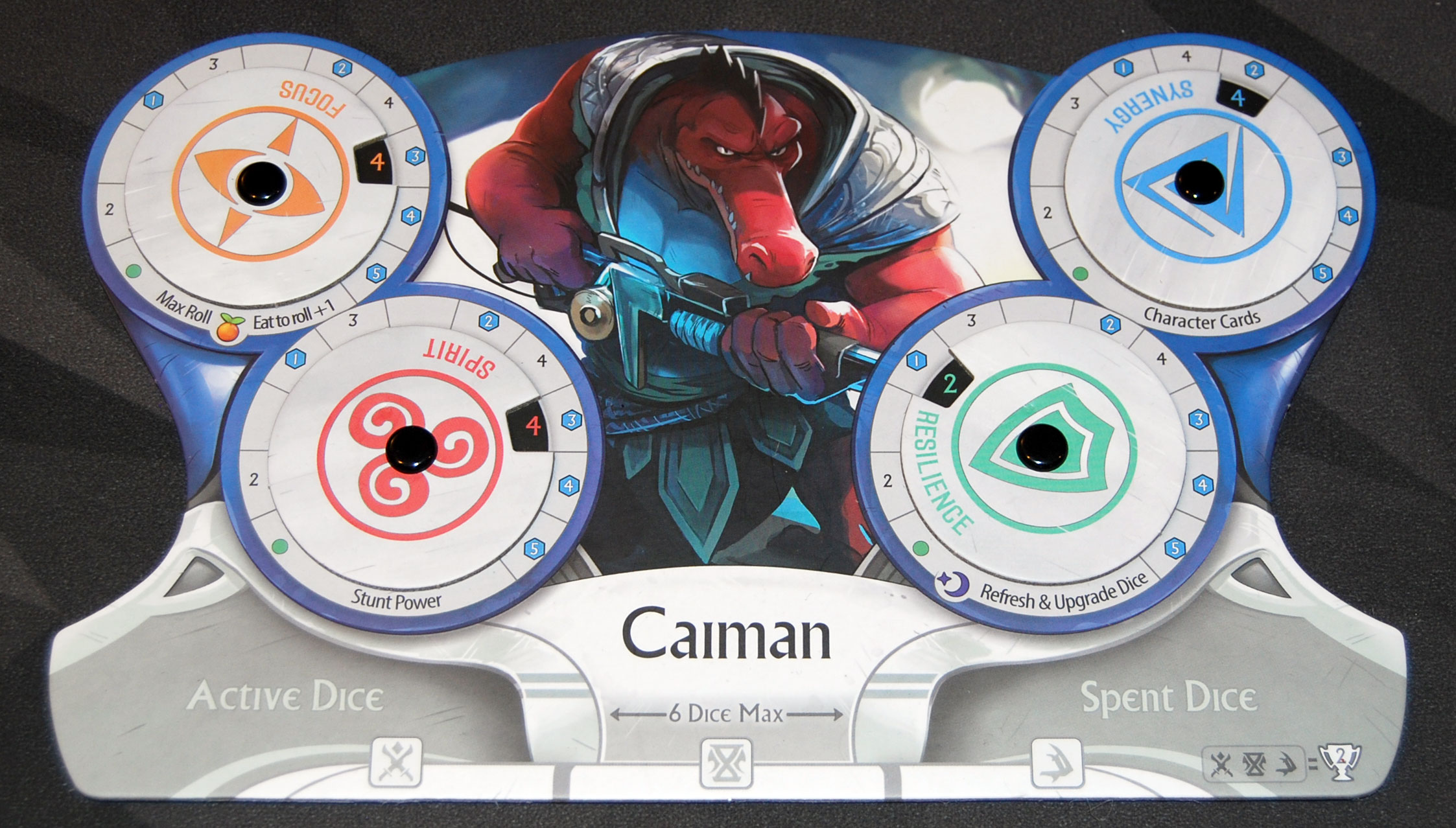
The first two things you’ll notice about Tidal Blades is that there are a lot of components, and they look great. The photo above has all of the island boards stacked because there simply wasn’t room to spread them out with everything else displayed—but you’ll see more in the setup photo later. The artwork for the game is by Mr. Cuddington, who also did a lot of the worldbuilding, and it’s beautiful. The characters and locations look like something out of an animated show and you’ll find yourself wishing you could watch a series about this world. I received a copy of the art and lore book, and was pleased to see that it read like a storybook, introducing you to both the setting and the individual characters in the game.
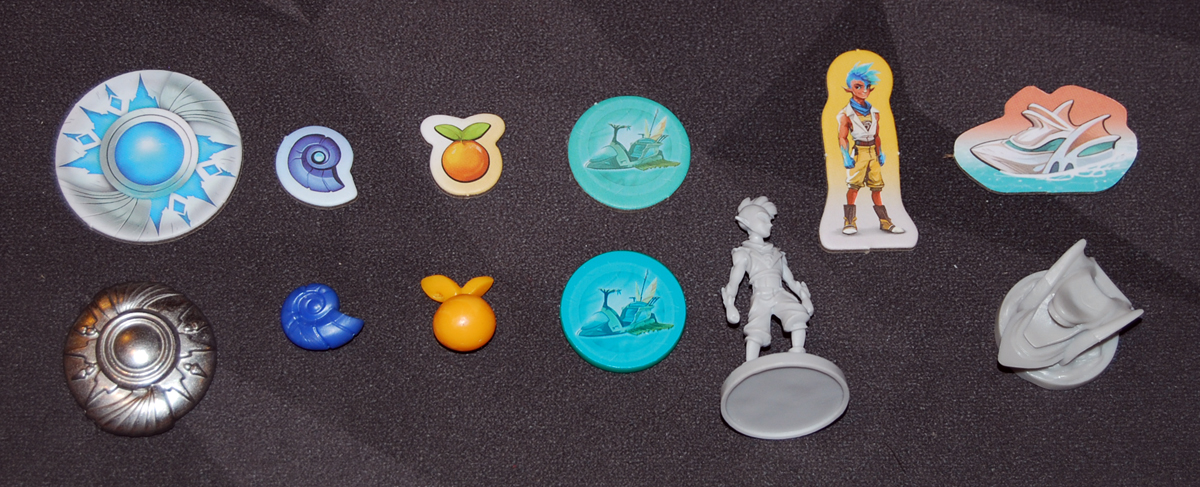
The primary difference between the basic and the deluxe editions are that many of the cardboard components get an upgrade: the first player marker is metal, the shells are made of plastic and the fruits are a squishy rubber. The action discs are also plastic, and there are miniatures to replace the standees. (Note that the deluxe edition does include the standees as well, in case you prefer those.) The deluxe also includes the big dice tray shaped like the Chronosseum, and the additional GameTrayz for everything to keep it all organized. It’s also in a significantly larger box: the basic version is a square (still pretty big), but the deluxe comes in a big rectangular box that will definitely not fit on your Kallax shelf.

The game boards are oddly shaped, allowing the artwork and design to dictate the shapes, making for a cool layout on the table, though you may have to experiment a little to get everything lined up. One nice note is the layout diagrams shown on the backs of each board, so it’s easy to figure out where everything goes. The other note is that the game is a table hog—between the six center boards and the four player boards, plus oodles of cards and tokens, it might get a little crowded. The first time I played the finished game with my kids, we actually set up on the floor in the living room.
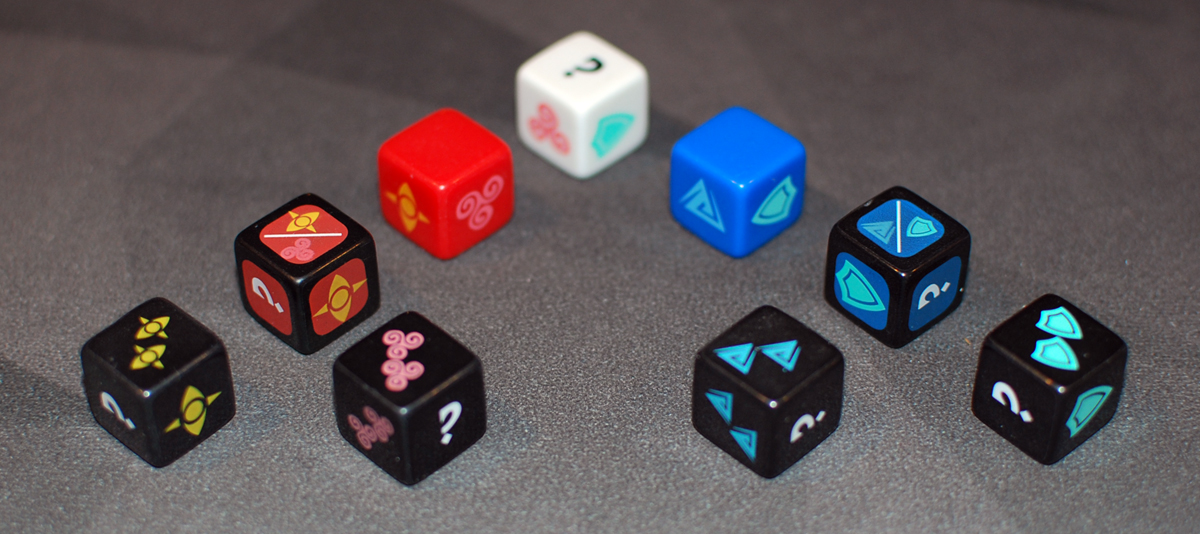
The various dice represent upgrading your skills; novice dice have the four traits, plus a wild and a blank side. Once you upgrade, you start to focus on either the cool colors or warm colors: initiate dice give you better odds for two of the traits but still have one blank face. Elite dice also include two faces that act as either of the two traits, and have no blank faces. Finally, the guild dice are even more specialized, with only one trait represented and some faces that include two of that trait; they also have two wild sides, so you still have a chance of rolling any symbol with them.
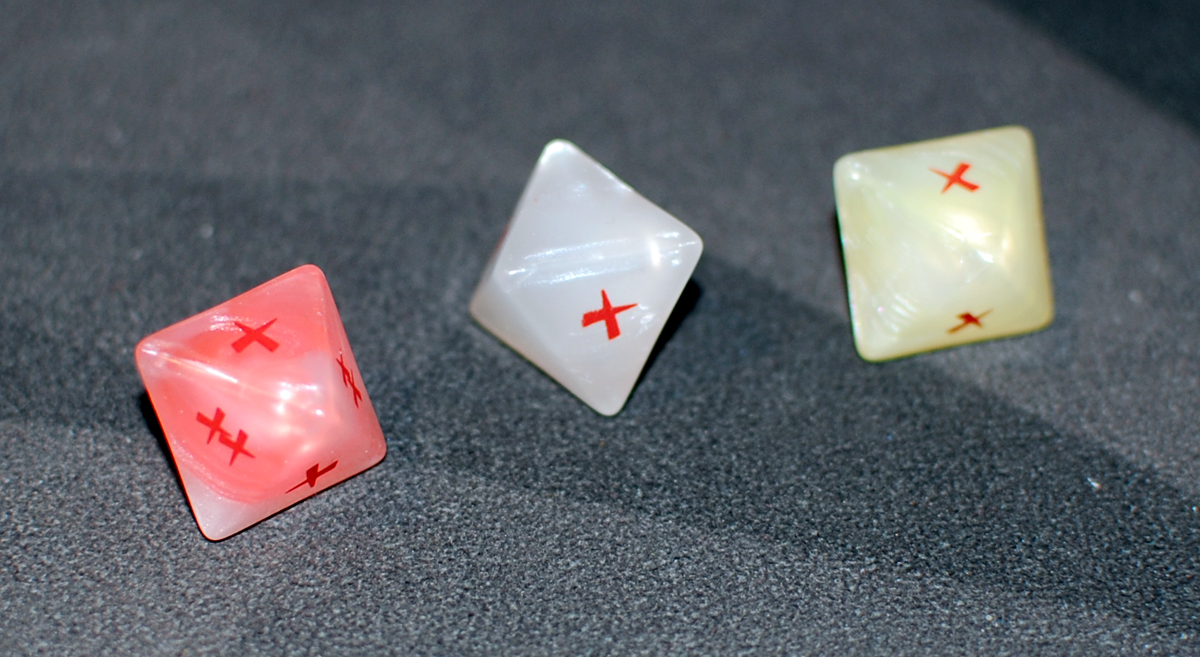
The danger dice are custom eight-sided dice that have some blank faces and some with 1 or 2 red X marks. These are used when battling the monsters, and indicate whether or not you take damage. They have a cool pearlescent color, but the red-on-red die can be hard to read in some lighting.

Each player has a unique set of character cards that can be unlocked during the game, so the characters are distinguished in more than just appearance. The goal cards are also different, though there are some more similarities and overlaps there. The player boards are identical in function, with four dials that track the traits (Focus, Spirit, Resilience and Synergy), but with the character’s portrait and name prominently displayed in the center.

The hit tokens are tiny cardboard squares with the character’s portraits on them, and they’re used to mark things like when you’ve done damage to a monster. In the basic version, each player uses a hit token to track their position on the Champion board as well. The one thing about them is that they’re very tiny, so you have to be careful not to bump them around when you move cards around.
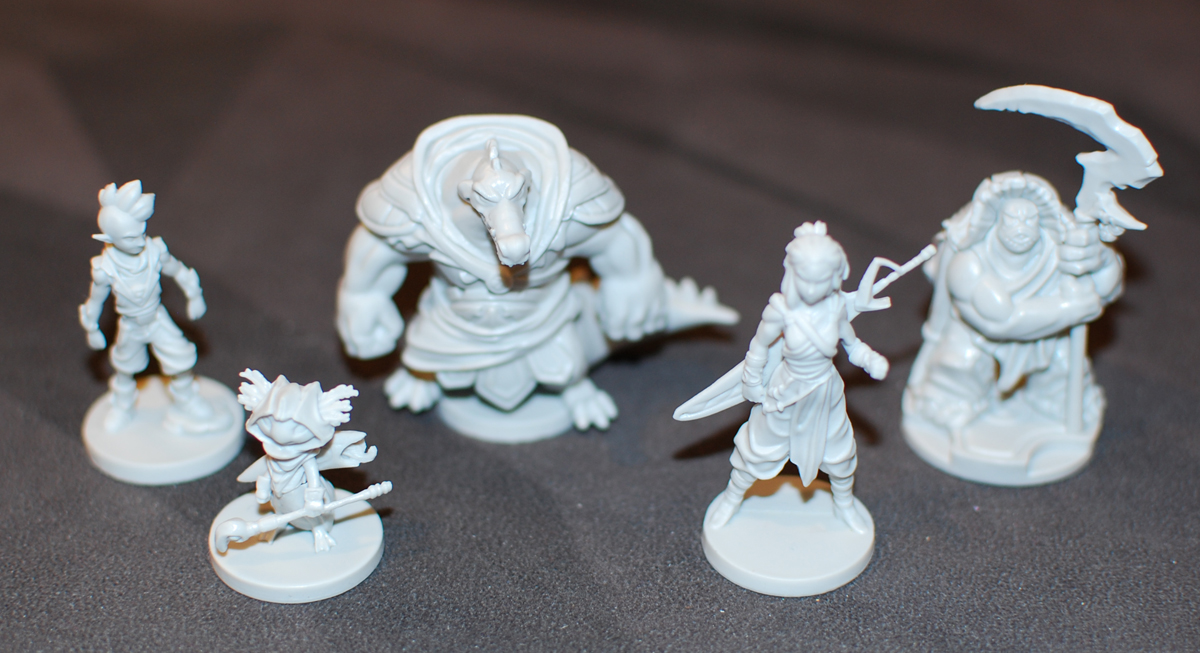
The deluxe edition comes with some miniatures: one for each hero, one for the judge, and a boat for the Lamara Stadium location. There are also small busts of each character, used for the champion board. The minis are nicely sculpted, and I love how different they look from each other—Caiman is enormous compared to Eko, so they’re all distinctive even if—like me—you aren’t able to paint them.
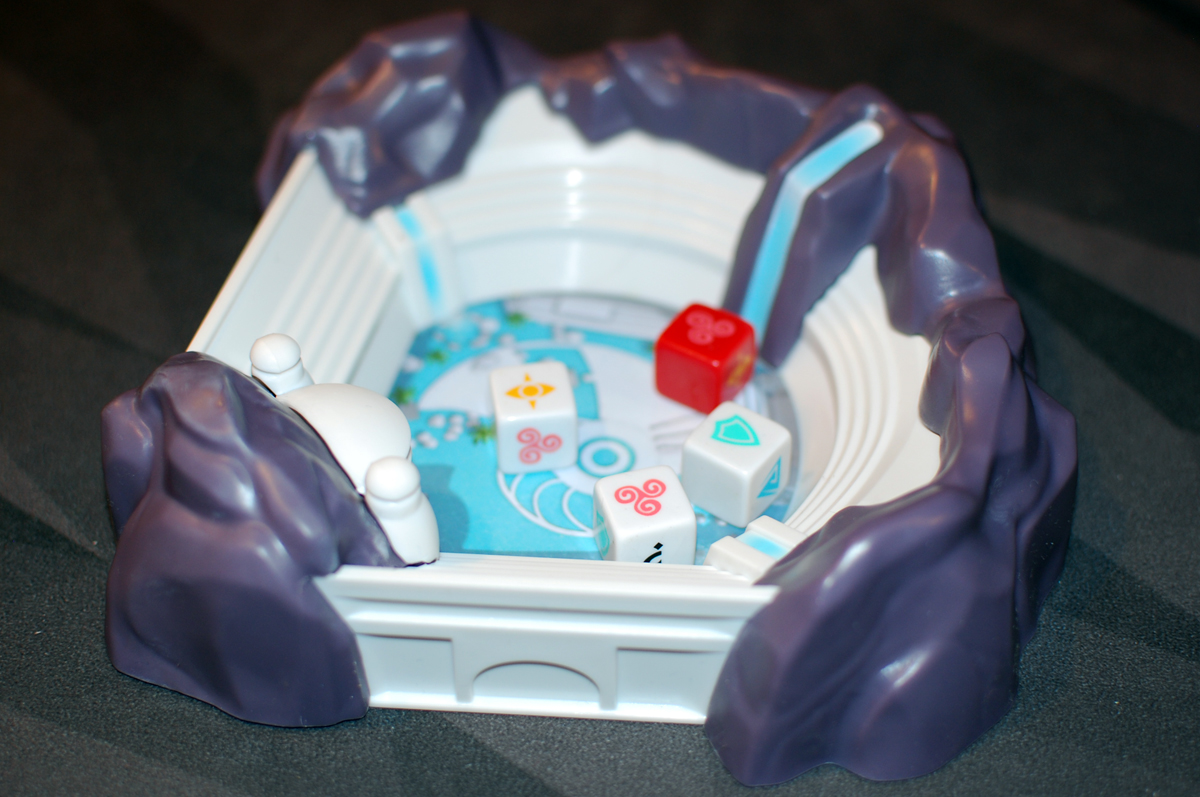
How to Play Tidal Blades: Heroes of the Reef
You can download a copy of the rulebook here.
The Goal
The goal of the game is achieve the highest score by leveling up your traits, completing challenges, fighting monsters, climbing the rankings on the champion board, and accomplishing your secret objective.

Setup
Each player gets a set of player components. All of the dials on the board are set to the lowest value. The four traits correspond to different abilities:
- Focus limits the number of dice you roll
- Spirit makes your stunt cards more effective
- Resilience is used for upgrading dice at the end of the round
- Synergy gives you access to more character cards
The player receives two novice dice (white) and places them in the “active dice” section of their player board; over the course of the game you can acquire up to 6 dice total. The standee and two of the energy discs are placed on the center of the player board; the other two discs will be placed on the Citadel of Time board. Each player also receives 2 fruit and 4 shells.
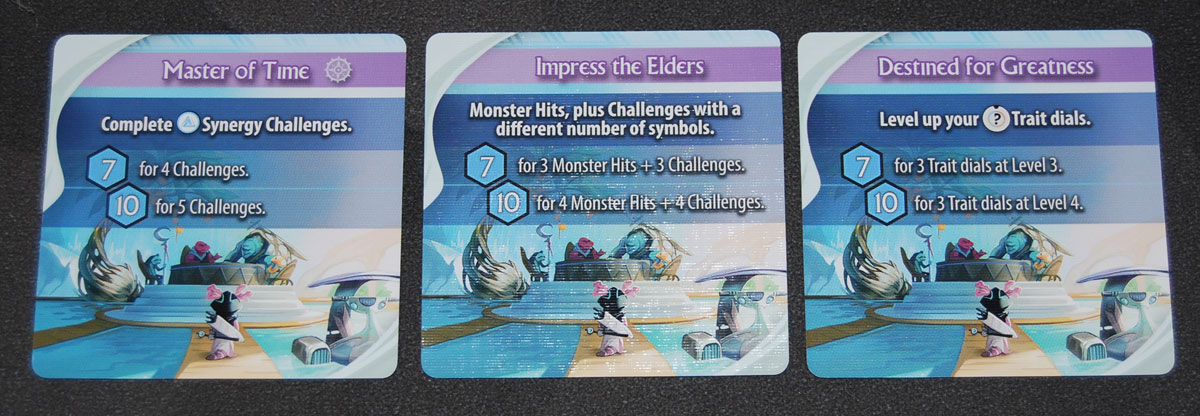
Each player also starts with their 3 starting challenge cards (marked with the character portrait), their Shell Shield character card and one other character card (chosen from 3 random or else from a suggested starting card); the rest of your character cards are shuffled and placed in a deck. Each player also starts with one randomly drawn secret goal card, which is placed face-down, and the other secret goals are returned to the box.
Choose a starting player and give them the first player marker. There are also some resource bonuses given to the other players.

In the center of the table are several boards. (Sorry, for this photo I left the monster invasion and damage dice in the tray rather than on their spaces.)
- The Fold: Place the monster deck (easier monsters on top, harder monsters underneath) and the monster invasion die here.
- Citadel of Time: Place the challenge deck here, with 5 challenge cards face-up above it. The round marker and danger dice go here, as well as two energy discs per player on the Round 2 and Round 4 spaces.
- Chronosseum arena: Place the stunts deck here.
- Champion board: Each player places one damage token (or Champion tracker) in the “start” space.
- Droska Ring arena: Place the market deck to the left, with 3 cards turned face-up to form the market.
- Lamara Stadium arena: Place the boat token on the starting space, center left.
The Elder Tidal Blade standee is placed on a random arena. The three arenas—the Chronosseum, Droska Ring, and Lamara Stadium—each have a colored space for it. The fruit, shells, and dice are placed nearby.
Gameplay
Tidal Blades is a worker-placement game: you place your energy discs on various places to gain the bonuses there; in addition, whenever you visit one of the islands, you also get that island’s bonus action; at the three arenas, you may also attempt a challenge from your hand. Most of the locations have space for only one disc, so once it is taken, nobody else may visit that location until the next round. Your standee always moves to your most recently placed disc.
Unlike most worker-placement games, you may visit an island even if there are no more locations available—your disc is just placed on the island board but not on a specific location on the board, and you’ll get the island bonus action but not the specific location action.
The bulk of the gameplay takes place during the Day phase, when players visit locations and take actions.
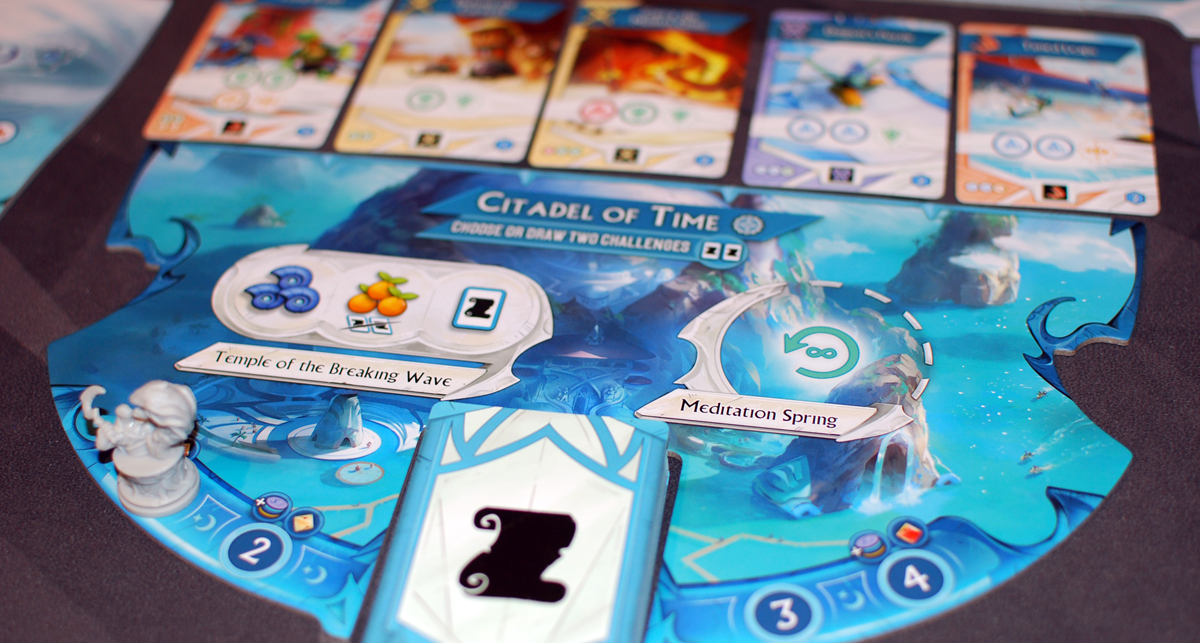
Citadel of Time
If you go to the Citadel of Time, you get to take two challenge cards, either from the face-up cards or off the top of the deck, sliding cards to the left and refilling as needed. Challenge cards have from 1 to 4 trait symbols on them, and also match one of the three arenas.
The Citadel of Time has two spots; one can hold up to 3 action discs, and the other can have any number. On the left you can gain shells, fruit (and refresh 2 challenge cards from the pool), or another challenge card (in addition to the ones you get just for coming to this board). On the right, you may refresh any number of your dice, moving them from “spent” to “active.”
The Citadel of Time, appropriately, also has the round track for the game.
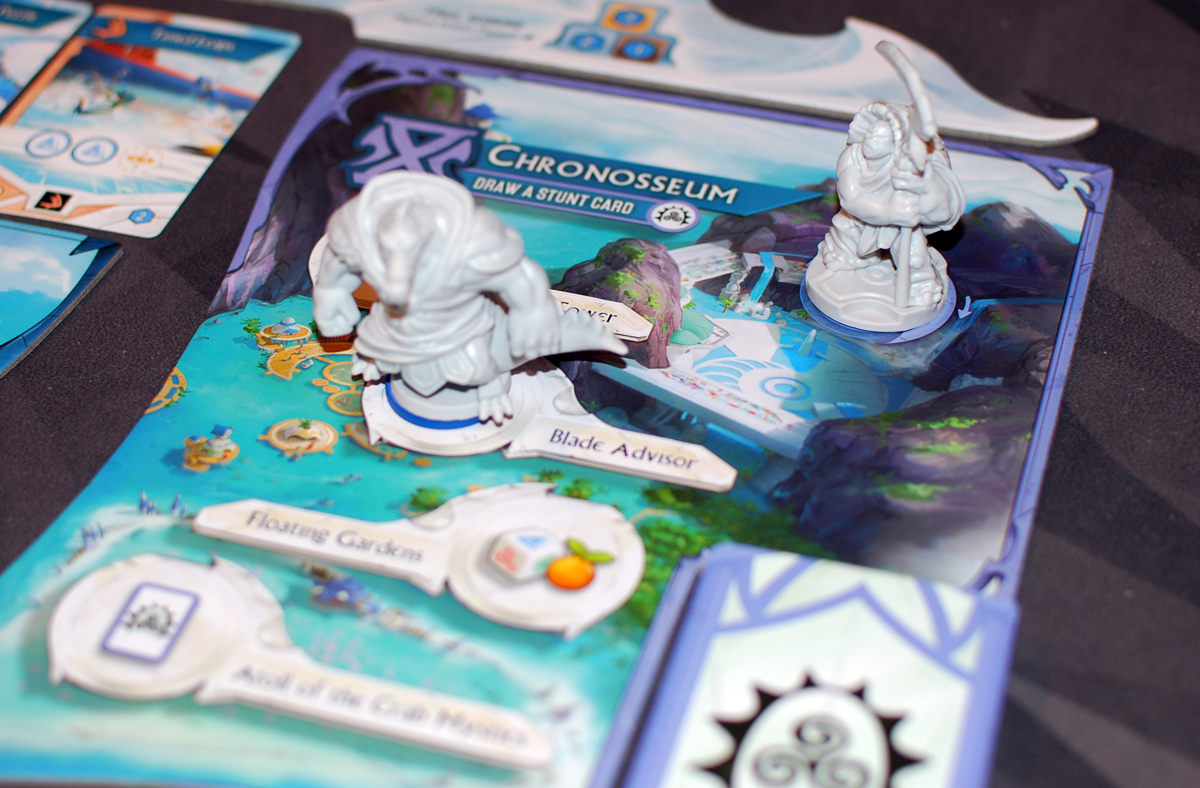
Chronosseum
At the Chronosseum, you get to draw a stunt card: these have different effects based on your Spirit level.
The Chronosseum has four spaces: you can gain a blue or red initiate die, a white die and a fruit, or another stunt card from the deck.

You may play stunt cards from your hand at any time during your turn, but only once per turn. Stunt cards give you various bonuses—more challenge cards, dice, resources, and so on—and they’re always tied to your spirit level. The higher your spirit, the more effective the stunt card will be.
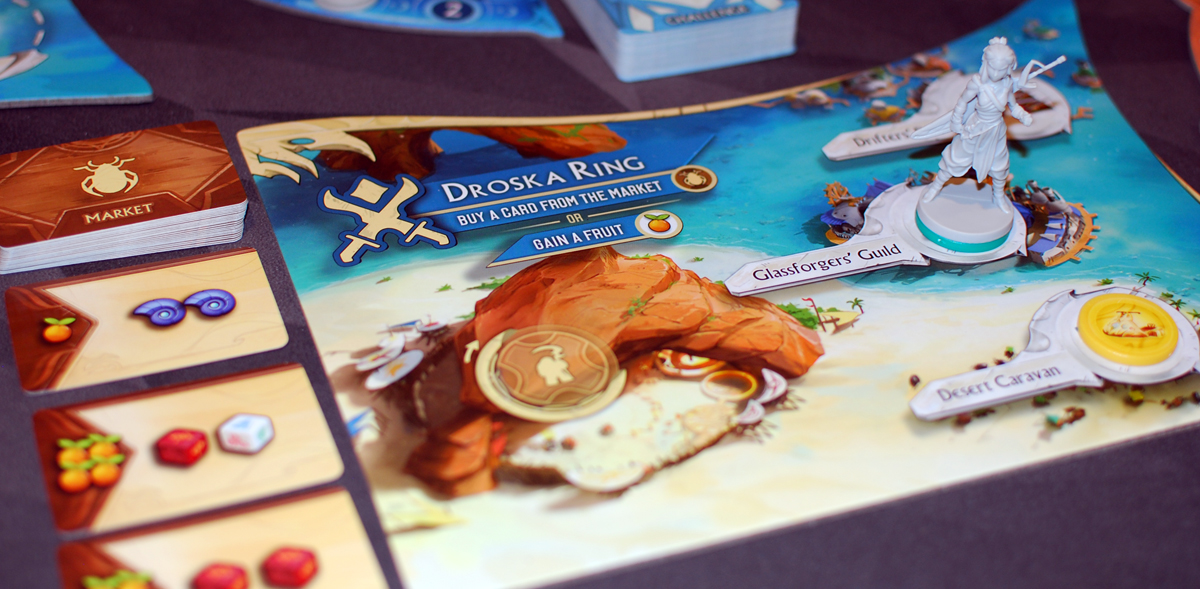
Droska Ring
At the Droksa Ring, you may buy a card from the market by spending fruit, or else gain a fruit.
The Droska Ring has three locations, where you can gain a fruit and refresh 2 market cards, 2 shells, or refresh dice equal to your Resilience level.

There are a variety of market cards, costing from 1 to 4 fruit, and they offer various bonuses: you may be able to increase a trait, move up on the champion board, gain dice, or buy resources or cards. The market cards take effect immediately and are discarded. Slide market cards down and refill from the deck as needed.
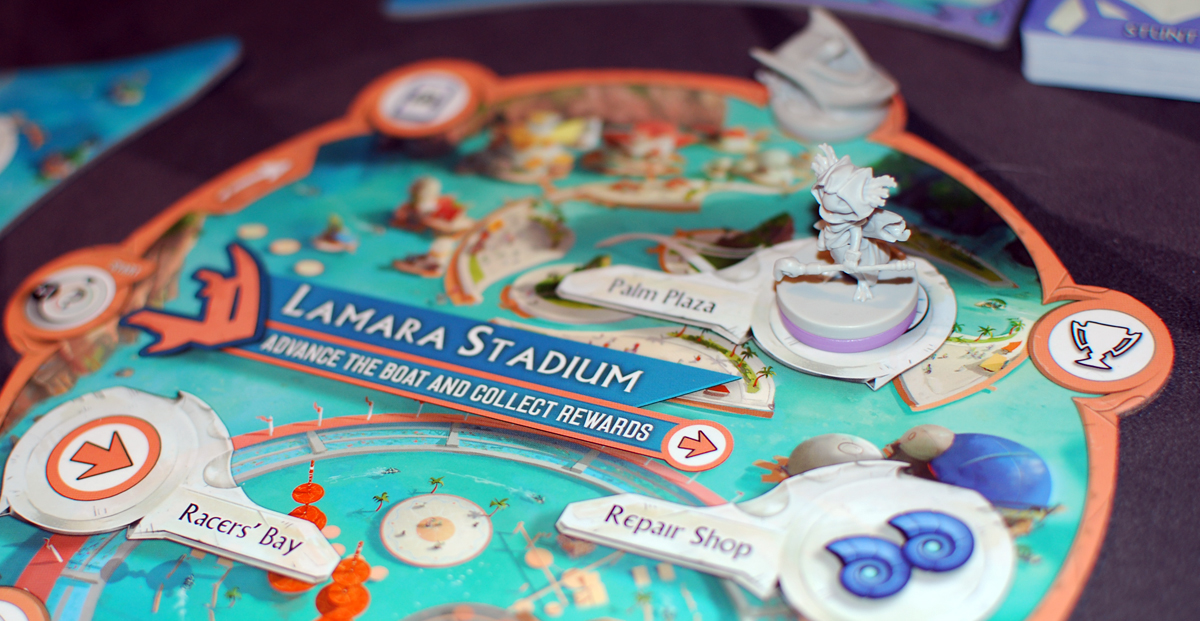
Lamara Stadium
The island bonus at Lamara Stadium is to move the boat one space clockwise around the outer edge of the board. You gain the printed bonus for every space that you land on, gaining resources, stunt cards, dice, or even increasing a trait.
Lamara Stadium has three locations: you may gain two fruit and the first player marker, two shells, or advance the boat an extra space.

The Fold
Finally, we have the Fold, a dimensional barrier that holds back the monsters … but the Fold is failing, and some monsters are getting through. There are two locations at the Fold, both of which can hold any number of discs and give you shells when you use them. At the Fold, you also attempt to battle monsters.
Each monster card has several symbols on it, indicating what you need to roll to hit it. There are some armored spaces that can only be hit with dice that are a certain level or higher—if you hit these, you also move up the champion board immediately. To fight a monster, you roll your dice (your Focus level indicates how many dice you may roll) and the current danger die. You also get a bonus die: each monster has a fighting style that matches one of the three arenas. Depending on how many of that type of challenge you have completed, you will get a bonus die of the corresponding level. You must roll this die in the fight, but it doesn’t count against your focus level.
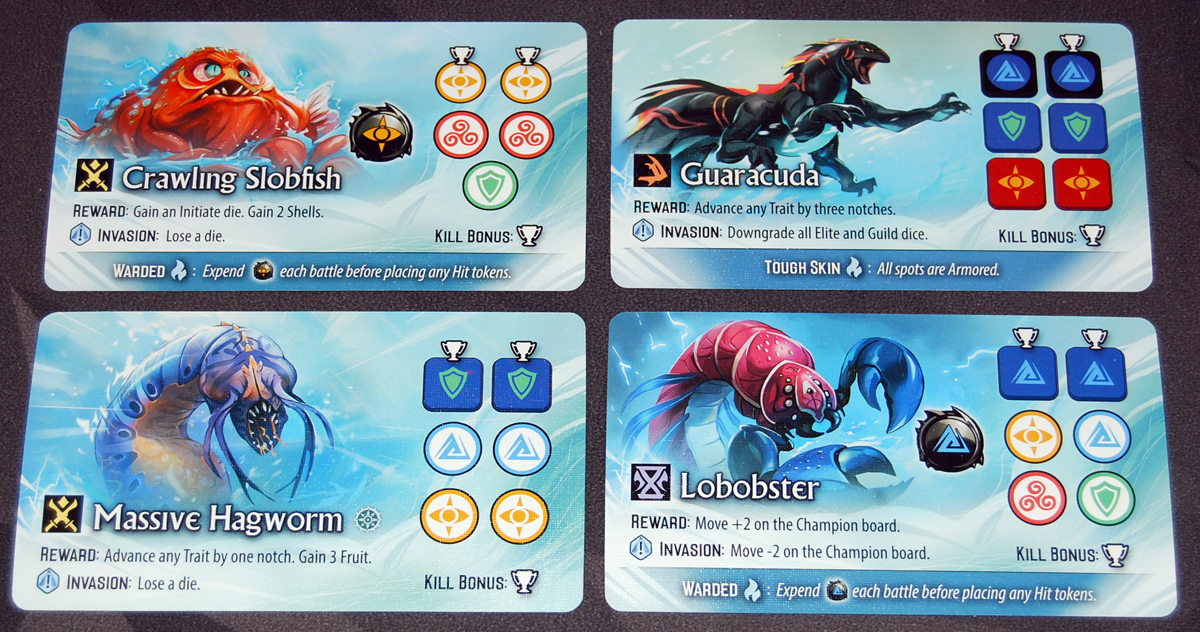
First, you check the danger die—if there are Xs showing, you must spend shells on your Shell Shield card to defend against them, or you will lose one of your rolled dice. You may choose to keep or re-roll any number of dice, but each time you re-roll you have to roll the danger die again and suffer the consequences. After you stop rolling, you may add hit tokens to matching spaces, which will increase your level for those traits. All dice you rolled for fighting the monster are lost and returned to the supply.
If you manage to land the last hit on a monster, you get the kill bonus, moving up on the champion board; everyone who has hit the monster will gain the reward. If a monster invades, anyone who has not hit the monster will suffer the invasion penalty.
Whenever a monster leaves the Fold (whether by being killed or by invading), any damage tokens on it are placed next to the Fold for final scoring.
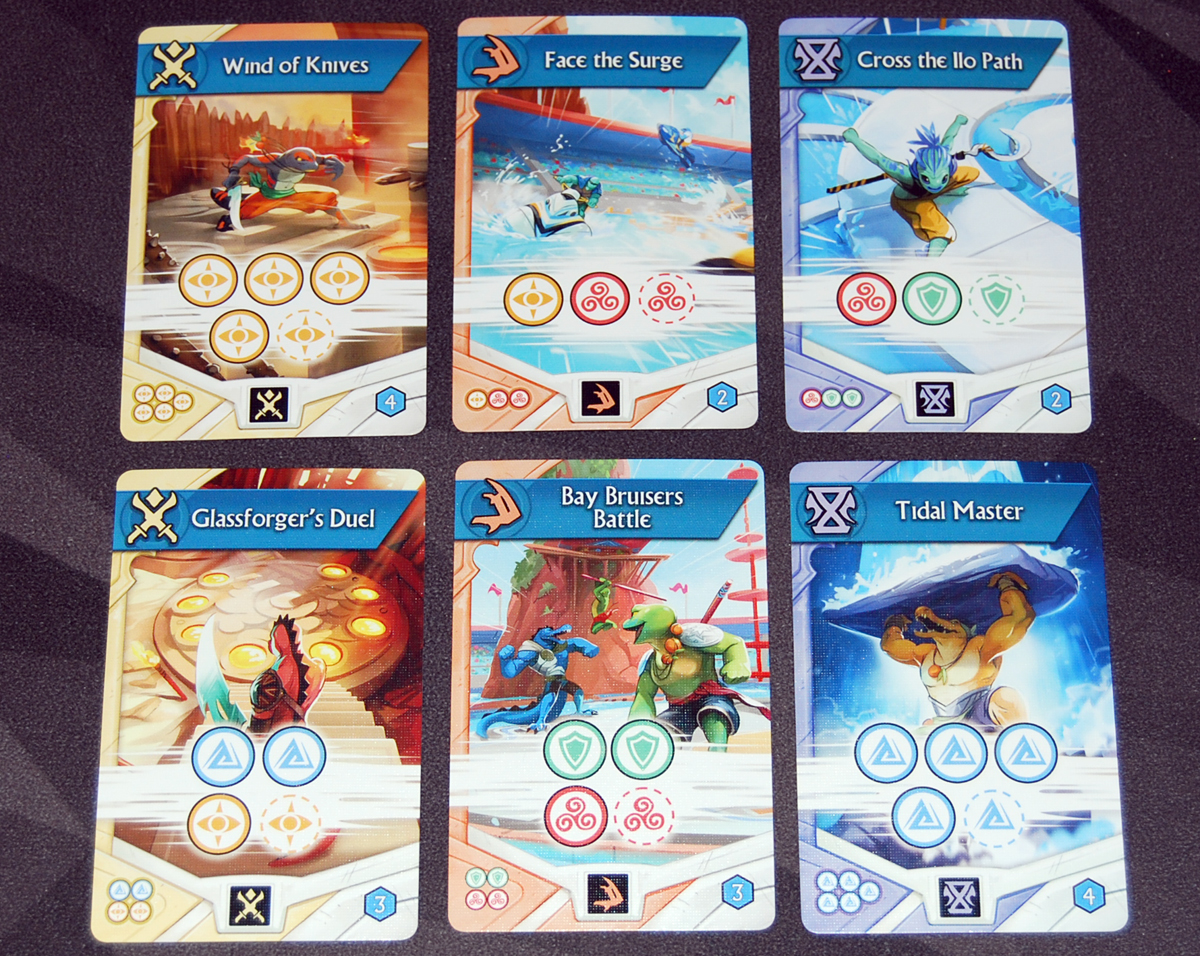
Challenges
To attempt a challenge, you will need to be at the matching arena: Droska Ring, Lamara Stadium, or the Chronosseum. After taking the location action and the island bonus action, you may attempt a challenge card from your hand. Reveal the card, and choose dice from your active dice to roll: you may roll dice up to your current Focus level, and you may spend fruit to roll additional dice. You also roll the current danger die—as the rounds progress, you use more difficult danger dice.
You may roll and re-roll any number of times, trying to get one die of each symbol on the card. (The symbol in the dotted line is the “Push It” symbol and is optional—if you match it, you also get to increase that trait, but you can complete a challenge without matching it.) However, each time you roll, you must also roll the danger die. Each X that is rolled on the danger die requires a shell on your shell shield to cancel it; if you cannot block all the Xs, you lose 1 die to the supply.
If you choose to stop rolling before you complete the challenge, you gain traits that you matched (but not the “push it” symbol). You discard the challenge and draw a new one from the deck. For each die that you lost to danger, gain 1 shell from the supply.
If you get all the symbols, you have completed the challenge. You increase the traits shown on the challenge card (one rank per symbol), and then tuck the challenge card face-up under your board in the matching column. All dice that you rolled for the challenge are placed in your spent dice area. If the Elder Tidal Blade is present at this location, you also move up one space on the champion board.
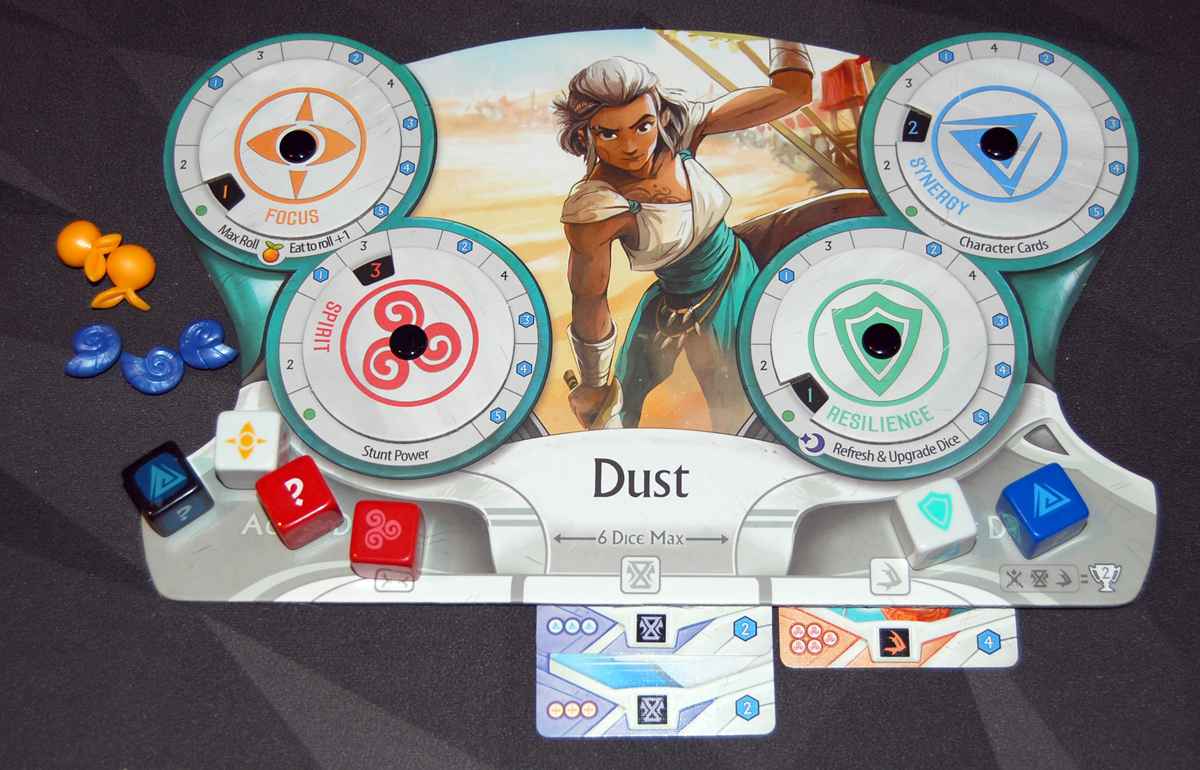
Each time you complete a row of one of each challenge type, you move 2 spaces on the Champion board.
Night Phase
After everyone has used all of their energy discs, the Day ends and the Night phase takes place.
The monster invasion die is rolled once—if the die matches a space with a monster on it, the monster invades. Anyone who has not damaged that monster suffers the penalty shown on the monster card.
Then, move monsters down one space and draw a new monster card. (If a monster was on the bottom space already, it flees, and anyone who has not hit it will move 1 space down on the Champion board.
Each player may upgrade dice according to their Resilience level. Take that number of dice from your active or spent dice; return each one to the supply and take a die that’s one rank higher, placing it into your active dice.
Return your standee and all discs to your player board.
Move the Elder Tidal Blade clockwise to the next arena.
Advance the round marker. At the start of Round 2 and Round 4, each player gains one energy disc, and the danger die is replaced with the next difficulty level. Whoever is highest on the Champion board gets to place a hit token on the “Leader Bonus” for that round. (Nobody gets the bonus if there’s a tie.)

Game End
The game ends at the end of 4 rounds. Players score as follows:
- Each completed challenge is worth the points shown on the card
- Your four traits are worth points if you cross the scoring thresholds
- Players in 1st, 2nd, and 3rd place on the champion board score 3/2/1 points
- Everyone scores for the highest point vale they reached on the champion board
- Each player scores 1 point for each Leader bonus earned
- Each player scores for their secret goal card
- Each player scores 1 point for each of their hit tokens next to the Fold
The highest score wins! Ties go to the player who moved furthest on the Champion board, and then the most points from completed challenges.
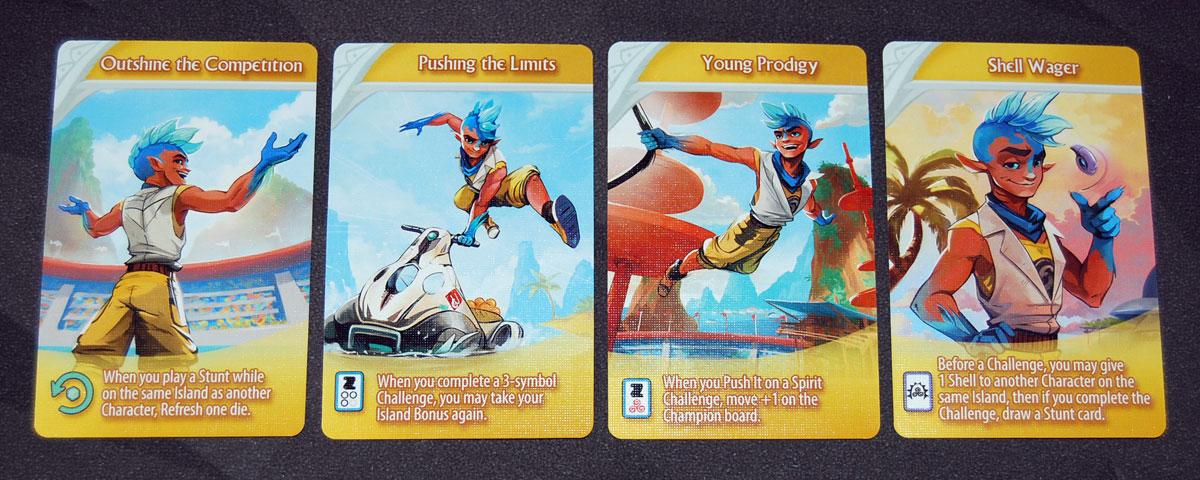
Why You Should Play Tidal Blades: Heroes of the Reef
When I played the Tidal Blades prototype back in 2018, I only got to keep it for a few days, but it was already a really impressive game, even with the hand-cut boards. Comparing the current rules to the prototype rules, I spotted a few differences here and there, but for the most part the core of the game remains the same. The game arrived during the pandemic, so unfortunately I haven’t gotten the chance to play the finished game as much as I’d like, but my kids and I have thrown down in the arenas and enjoyed the challenge.
I like the mix of worker placement with the dice management and character upgrades. The four traits lead you down different paths, and figuring out your approach is part of the fun. Going after Focus will let you roll more dice for challenges and monster fights, increasing your odds of success without having to roll the danger dice as much. But Resilience lets you upgrade dice, and better dice also increase your odds of success, just in a different way.
If you like stunt cards, then you’ll want to increase your Spirit as quickly as possible, and then spend time getting more stunt cards. Clever use of stunt cards can gain you a lot of benefits that would require more turns to acquire otherwise.
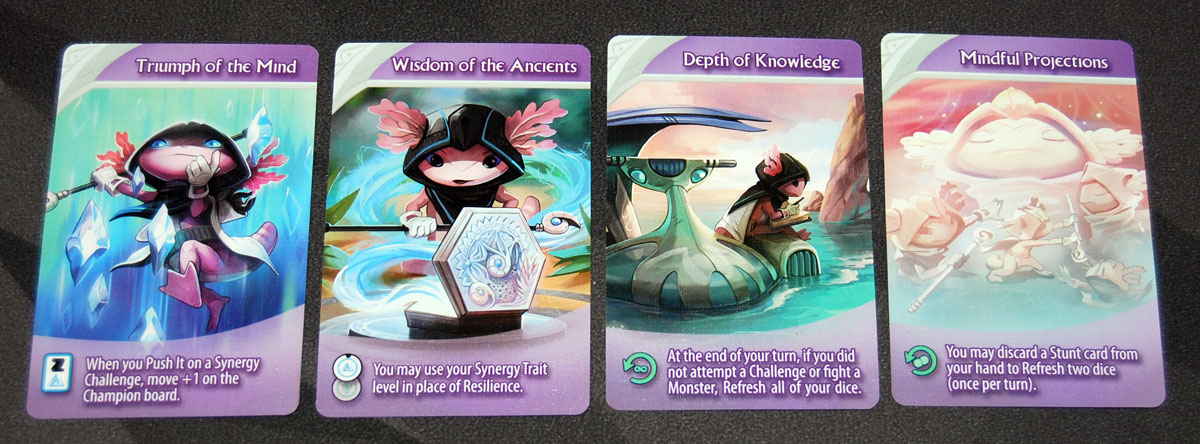
Finally, don’t forget about Synergy: each time you pass a level threshold, you get to draw two of your character cards and pick one to keep. Over the course of the game, you can have up to 4 character cards. Each character has a different mix of them, and unlocking them early in the game can give you a nice advantage, particularly if you pick a combination that meshes with your favorite tactics.
Typically the way you’ll increase traits is by completing challenges and fighting monsters, but there are a few other ways to do it, like completing a lap at Lamara Stadium, or visiting the Droska Ring market at just the right time. What that means is that even if you have a plan for which traits you want to pursue first, you still have to find the best way to level them up. I also like using shells from my shell shield to level up, but that means I cant use them to change dice values.

Each trait can be worth as many 5 victory points, but that’s only if you continue to invest in it after you’ve reached the maximum trait level of 4. How much time should you spend working on a trait that doesn’t give you any other benefits, particularly if your other traits aren’t leveled up yet?
The Champion board can be worth a lot of points—up to 10 if you hit the end of the track, plus a few bonus points for things like the Leader bonus or being ahead at the end of the game. However, depending on how close you are to a scoring threshold, it might be better to work on something else rather than simply pursuing that track.
At the start of the game, each player only has 2 energy discs, so you have to choose your two turns very carefully. If you don’t get more dice (or have Resilience to upgrade and refresh dice), then you’ll have to spend turns just to refresh dice, because most of the important actions that will score points require you to have dice. Managing your dice is a crucial part of the game; is it better to have fewer, higher-rank dice or more, lower-rank dice?
I do like that everyone gets additional energy discs at the same time. In many worker-placement games, gaining additional workers is one of the best tactics, because the more workers you have, the more you can do. Players who miss out often get left behind. In this case, everyone gets workers at the same time, so your actions are restricted more by how many active dice you have left than the number of energy discs. As the game progresses, the rounds get longer—but you always feel like you could do so much if you had just one more turn.
I like the way that the various elements of the game tie into each other: completing challenges not only scores points but also makes you better at fighting monsters. Fighting monsters isn’t just worth points, but also protects you if they invade.

The character cards, gained when you increase Synergy, have some very cool abilities that you can unlock during the game. While each character has a couple of traits that they favor, you’re not locked into a particular style based on the character, either—it depends on a mix of which trait cards you happen to draw and pick, and the other choices you’ve made about your traits and dice. I like the little stories that give you a little more insight into your character.
Tidal Blades is just jam-packed with cool artwork, tricky choices, and fun gameplay. I enjoyed immersing myself in the theme, and we did feel like competitors in a high-stakes contest, wanting to win but also building camaraderie with our fellow hopefuls, unlocking new abilities as we leveled up our traits. There’s a lot going on in this reef, but it’s worth a visit!
Visit the Skybound Games site if you’d like to order the basic or deluxe edition. And, while you’re at it, take a look at the Tidal Blades 2 Kickstarter campaign—there’s only a few days left!
Click here to see all our tabletop game reviews.
![]() To subscribe to GeekDad’s tabletop gaming coverage, please copy this link and add it to your RSS reader.
To subscribe to GeekDad’s tabletop gaming coverage, please copy this link and add it to your RSS reader.
Disclosure: GeekDad received a copy of this game for review purposes.
Click through to read all of "Reaping the Rewards: ‘Tidal Blades: Heroes of the Reef’" at GeekDad.If you value content from GeekDad, please support us via Patreon or use this link to shop at Amazon. Thanks!

